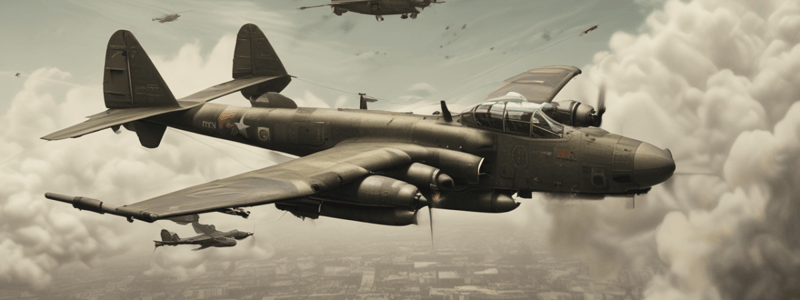Podcast
Questions and Answers
What happens to the pitch attitude at launch as the range increases?
What happens to the pitch attitude at launch as the range increases?
- It decreases
- It remains constant
- It becomes more unpredictable
- It increases (correct)
What is the primary kill mechanism of explosive munitions?
What is the primary kill mechanism of explosive munitions?
- Fragmentation (correct)
- Shaped charge
- Spall
- Blast
What is produced by the target structure itself when a weapon strikes?
What is produced by the target structure itself when a weapon strikes?
- Spall (correct)
- Fragmentation
- Blast
- Recoil
What can cause significant variation in first and subsequent round placements?
What can cause significant variation in first and subsequent round placements?
What is the angular rate error effectively negligible for?
What is the angular rate error effectively negligible for?
What describes a projectile's characteristics and effects on a target?
What describes a projectile's characteristics and effects on a target?
What is more sensitive to down-wash effects than 30-mm projectiles?
What is more sensitive to down-wash effects than 30-mm projectiles?
What is influenced by fuze and warhead functioning, impact angle, and surface condition?
What is influenced by fuze and warhead functioning, impact angle, and surface condition?
What is the purpose of the Bump in a diving/running fire profile?
What is the purpose of the Bump in a diving/running fire profile?
What is dispersion in the context of artillery fire?
What is dispersion in the context of artillery fire?
What is the purpose of selecting an Initial Point (IP) in diving/running fire?
What is the purpose of selecting an Initial Point (IP) in diving/running fire?
What is RMAX in the context of artillery fire?
What is RMAX in the context of artillery fire?
What type of terrain may eliminate the need for a Bump in a diving/running fire profile?
What type of terrain may eliminate the need for a Bump in a diving/running fire profile?
What is the most useful weapons range for tactical planning?
What is the most useful weapons range for tactical planning?
How many types of ballistics are there?
How many types of ballistics are there?
What is the purpose of the Perch in a diving/running fire profile?
What is the purpose of the Perch in a diving/running fire profile?
What is the correct format for the observer's initial call to the aircraft?
What is the correct format for the observer's initial call to the aircraft?
What information is included in the Target Location element?
What information is included in the Target Location element?
What is the purpose of the Remarks element?
What is the purpose of the Remarks element?
What is the effect of stating 'danger close' in the Remarks element?
What is the effect of stating 'danger close' in the Remarks element?
What is the purpose of stating 'at my command' in the Remarks element?
What is the purpose of stating 'at my command' in the Remarks element?
What is the correct response from the aircraft when ready to fire?
What is the correct response from the aircraft when ready to fire?
What is the effect of airspace clearance between the employing aircraft and the target?
What is the effect of airspace clearance between the employing aircraft and the target?
What is the purpose of including the observer's or commander's initials in the Remarks element?
What is the purpose of including the observer's or commander's initials in the Remarks element?
What is the primary reason for verifying torque during rocket engagements?
What is the primary reason for verifying torque during rocket engagements?
What is the main purpose of using the four T's (target, torque, trim, and target) during rocket engagements?
What is the main purpose of using the four T's (target, torque, trim, and target) during rocket engagements?
What is the result of steep dive angles (>25 degrees) during rocket engagements?
What is the result of steep dive angles (>25 degrees) during rocket engagements?
What is the primary concern when flying at high rates of descent and high flight-path speeds during rocket engagements?
What is the primary concern when flying at high rates of descent and high flight-path speeds during rocket engagements?
What is the effect of steep dive angles on rocket dispersion around the aim point?
What is the effect of steep dive angles on rocket dispersion around the aim point?
What is the primary concern when a pilot experiences target fixation during rocket engagements?
What is the primary concern when a pilot experiences target fixation during rocket engagements?
What is the purpose of verifying trim during rocket engagements?
What is the purpose of verifying trim during rocket engagements?
What is the result of mushing during rocket engagements?
What is the result of mushing during rocket engagements?
What does the 'Capture' call indicate during a missile engagement?
What does the 'Capture' call indicate during a missile engagement?
What is the purpose of the 'Laser on, time flight, _____ seconds' call during a LOAL engagement?
What is the purpose of the 'Laser on, time flight, _____ seconds' call during a LOAL engagement?
What is the primary advantage of the 'Buddy Laser' technique?
What is the primary advantage of the 'Buddy Laser' technique?
What is a key consideration when initiating the 'Buddy Laser' sequence?
What is a key consideration when initiating the 'Buddy Laser' sequence?
What is the primary purpose of the Shift Cold Procedure?
What is the primary purpose of the Shift Cold Procedure?
Who typically initiates the 'Buddy Laser' sequence?
Who typically initiates the 'Buddy Laser' sequence?
What is the benefit of using the 'Buddy Laser' technique in terms of backscatter?
What is the benefit of using the 'Buddy Laser' technique in terms of backscatter?
What is the primary reason for the 'Buddy Laser' technique to be used in close proximity to the shooting aircraft?
What is the primary reason for the 'Buddy Laser' technique to be used in close proximity to the shooting aircraft?
Flashcards are hidden until you start studying
Study Notes
Diving/Running Fire Profile
- Maximize benefits of both running and diving fire with a low-altitude run-in and a 300- to 1,000-foot climb (Bump) about 1,500 to 2,000 meters prior to the target.
- In mountainous terrain, the relative position of the sloping terrain provides the same effect, eliminating the need for a Bump.
Initial Point (IP)
- IP is selected about 8 to 10 kilometers from the target to provide time and space to set up a running or diving fire attack.
- IP should be a readily identifiable terrain feature or a TSD/C-Scope icon.
Dispersion
- Dispersion is the degree of scatter (or variance of range and azimuth) of rounds, caused by the combination of weapons design and ballistic errors.
- Dispersion and accuracy determine whether a particular weapon can hit an intended target.
Ranges
- Kinematic range is the maximum distance that a round can physically fly.
- RMAX is the distance at which a defined target can be hit (though not necessarily defeated).
- Maximum effective range (RMe) is the distance at which there is a 50-percent probability of both hitting and defeating a target.
Ballistics
- Four types of ballistics: interior, exterior, aerial, and terminal.
- Aircraft pitch attitude at launch increases as range increases, resulting in steeper impact angle.
- Launch platform altitude also affects impact angle.
Fragmentation
- Fragmentation is the primary kill mechanism of explosive munitions.
- Fragmentation travels further than blast and is more versatile than shaped charges.
- Spall is produced when a weapon strikes a target, releasing high-speed debris that can cause considerable damage.
Gunship CFF Format
- Observer and Warning Order: “[Aircraft call sign], [observer call sign], this is [observer call sign], fire mission, over.”
- Friendly Location and Mark: “My position [grid], marked by [strobe, beacon, etc.].”
- Target Location: “Target Location [bearing (magnetic) and range (meters), grid, etc.].”
- Target Description and Mark: “[Target description], marked by [infrared pointer, tracer, etc.].”
- Remarks: “[Clearance, danger close, at my command, threats, restrictions, etc.], over.”
Rocket Engagements
- Use the four T’s (target, torque, trim, and target) to enhance accuracy.
- Verify torque and trim to maintain altitude and eliminate angular rate error.
- Steep dive angles (>25 degrees) result in large rates of change in aircraft flight parameters and present flight safety challenges.
- Target fixation can cause a pilot to fly the aircraft into the ground.
- Mushing may make dive recoveries difficult.
- Steeper dive angles compress the range error for rockets significantly and result in less dispersion around the rocket aim point.
Laser and Remote Designation
- Capture call indicates the designating aircraft is in position and has “captured” the laser spot on the target.
- LOAL (Lock-On After Launch) sequence: “Laser on, time flight, _____ seconds”, based on range/time of flight and required/maximum delay time.
- Buddy Laser technique is a simplified remote engagement used by aircraft within a flight/team.
- Shift Cold Procedure is a risk avoidance method when aborting a missile engagement with a missile in flight.
Studying That Suits You
Use AI to generate personalized quizzes and flashcards to suit your learning preferences.




